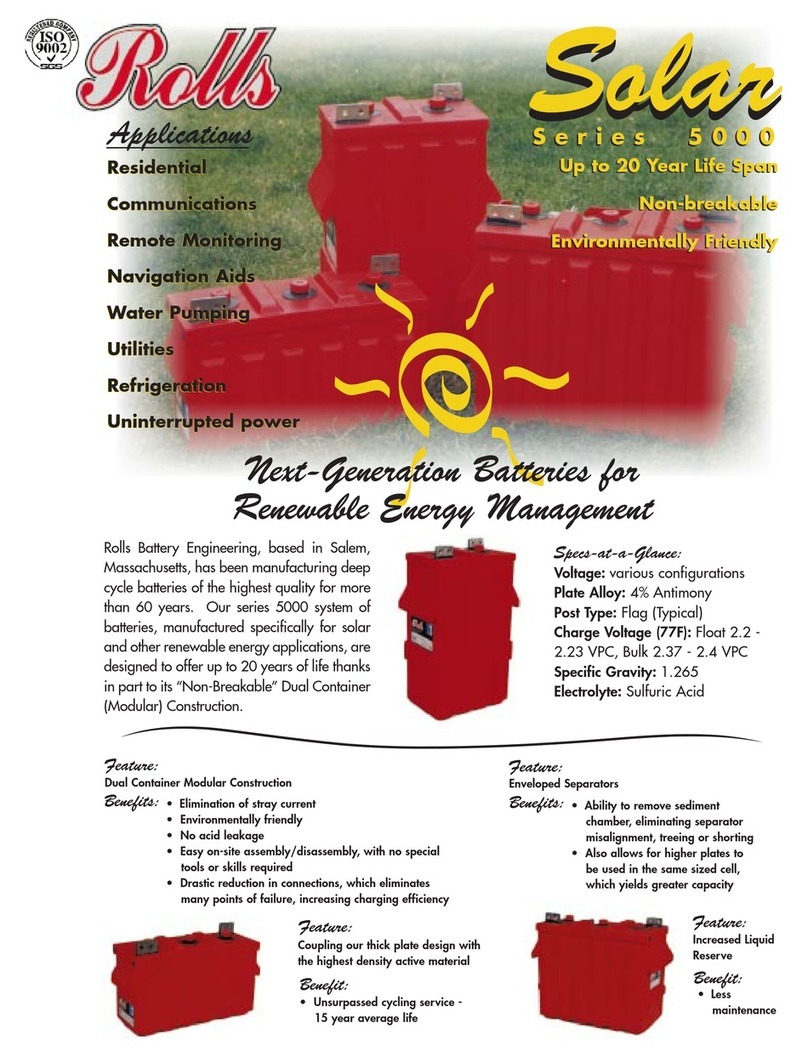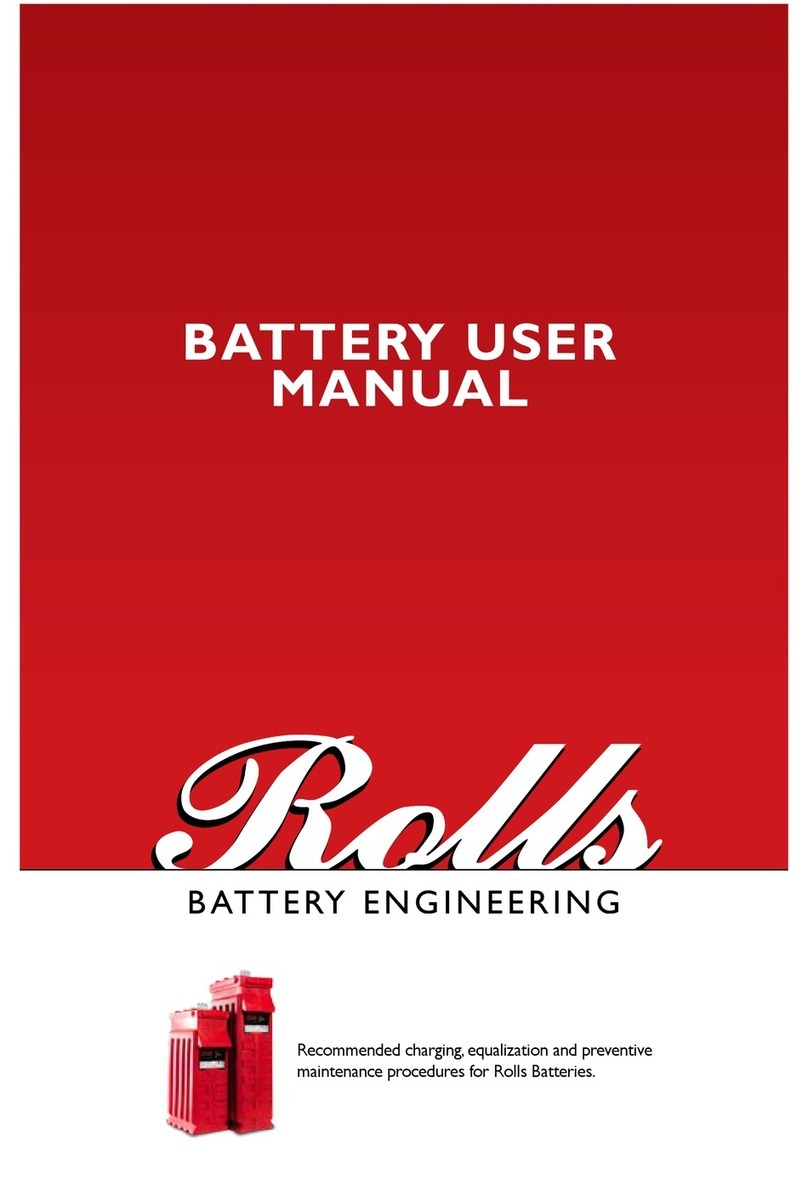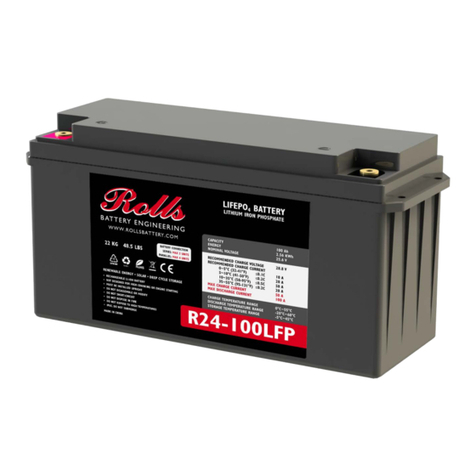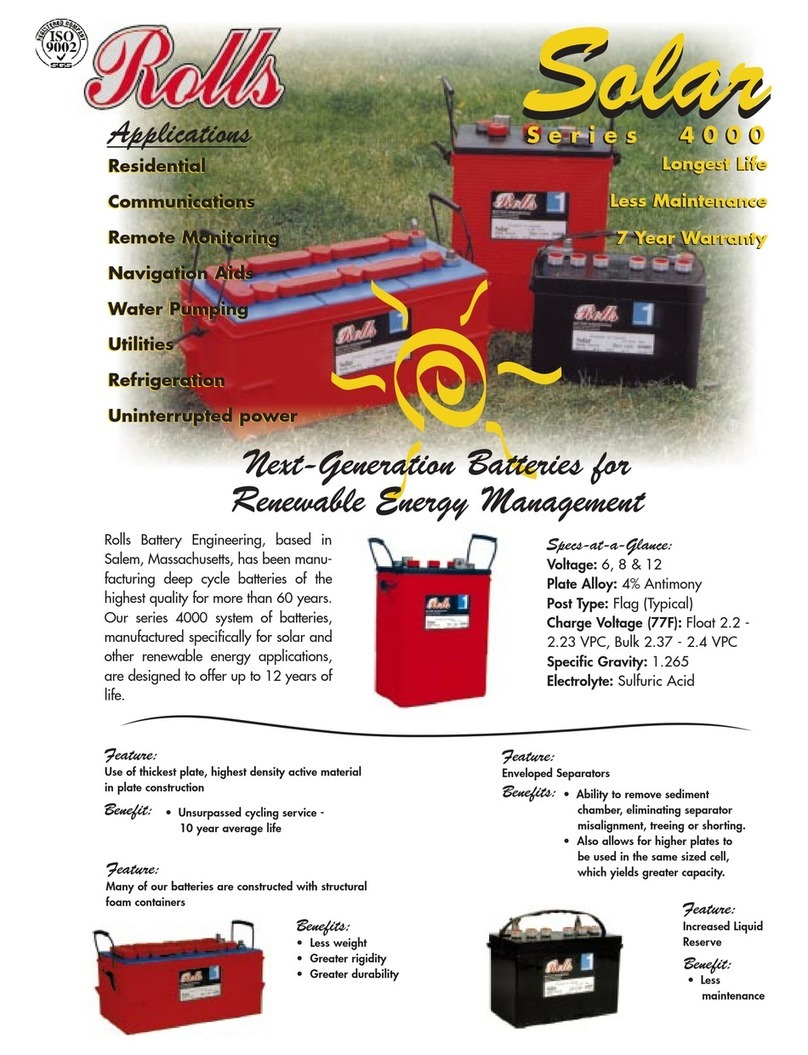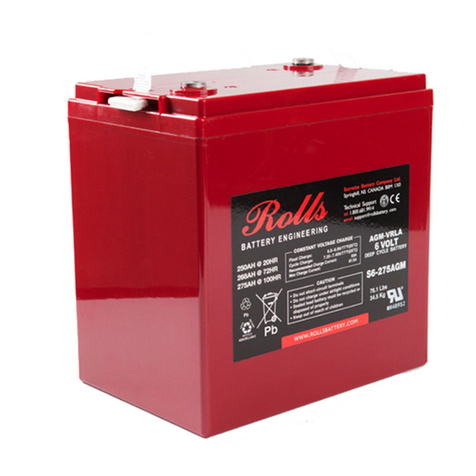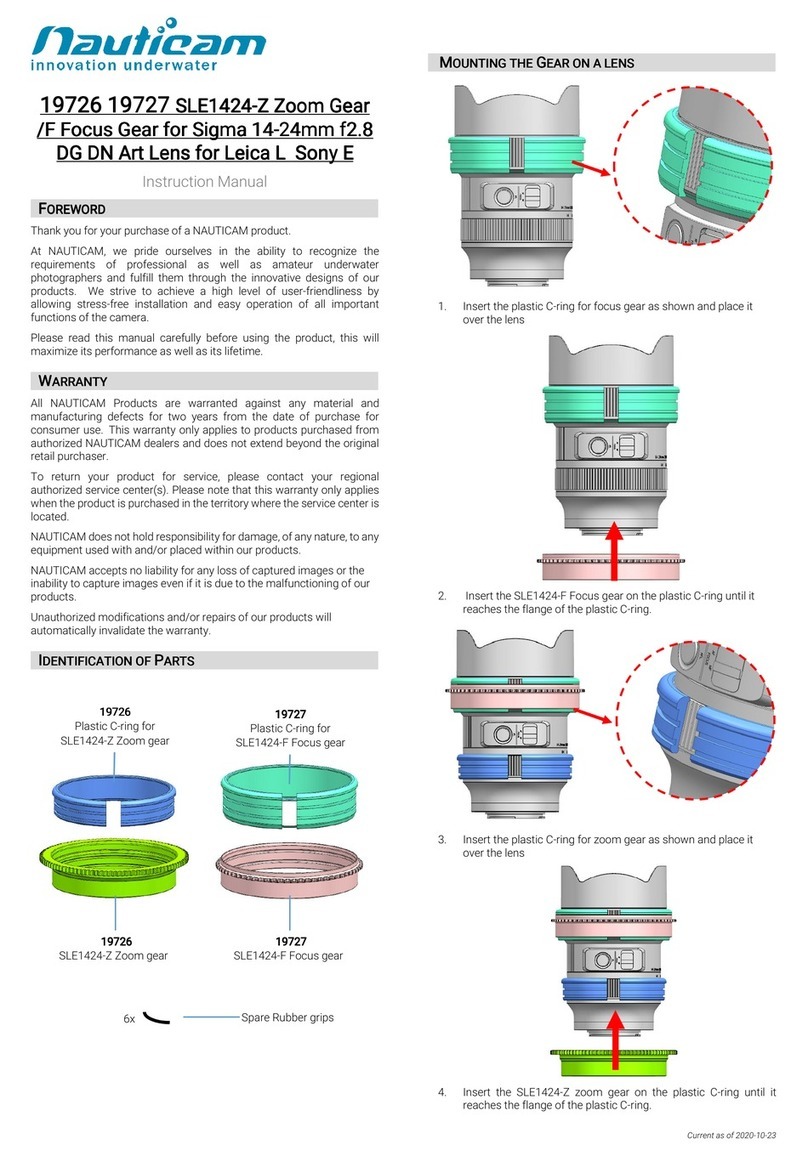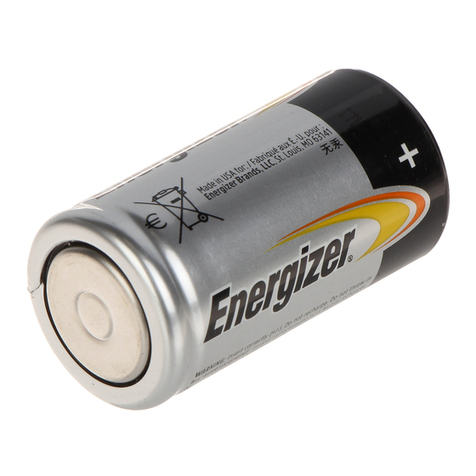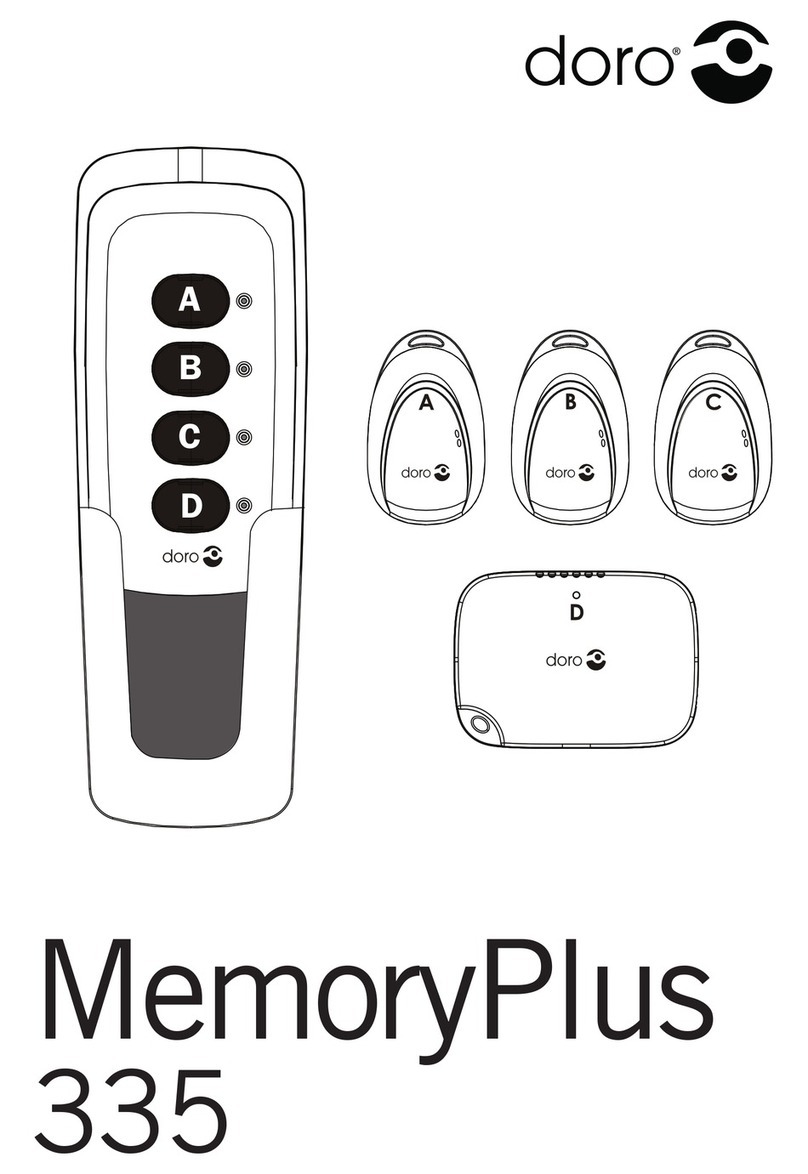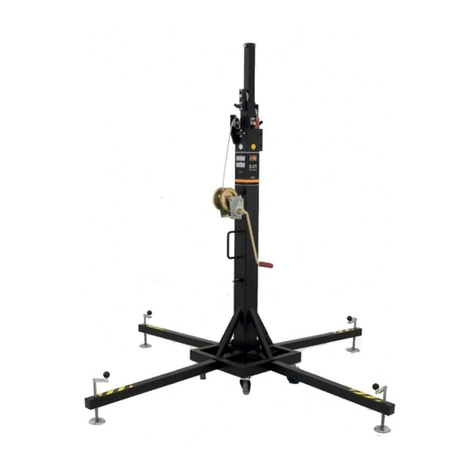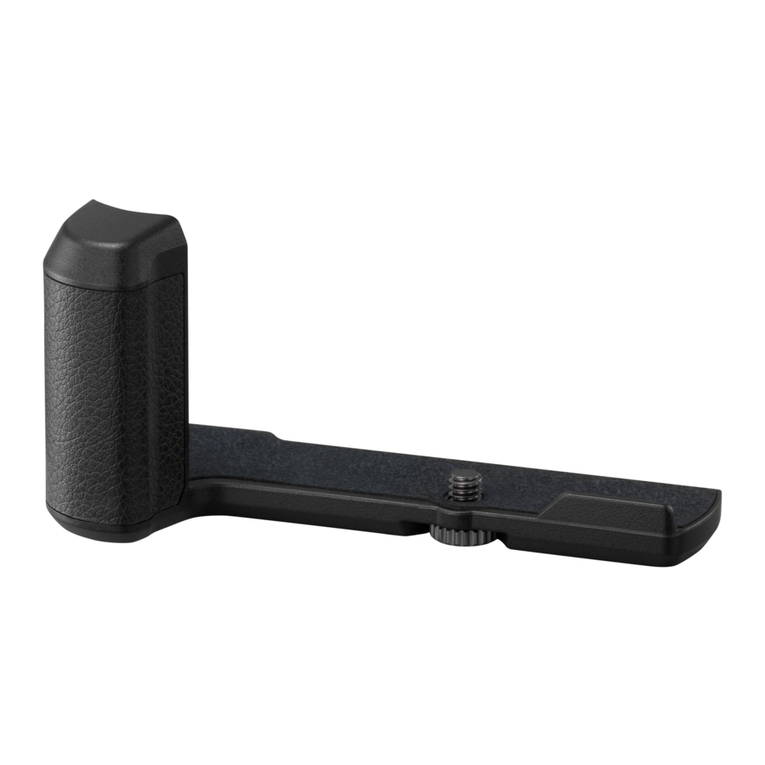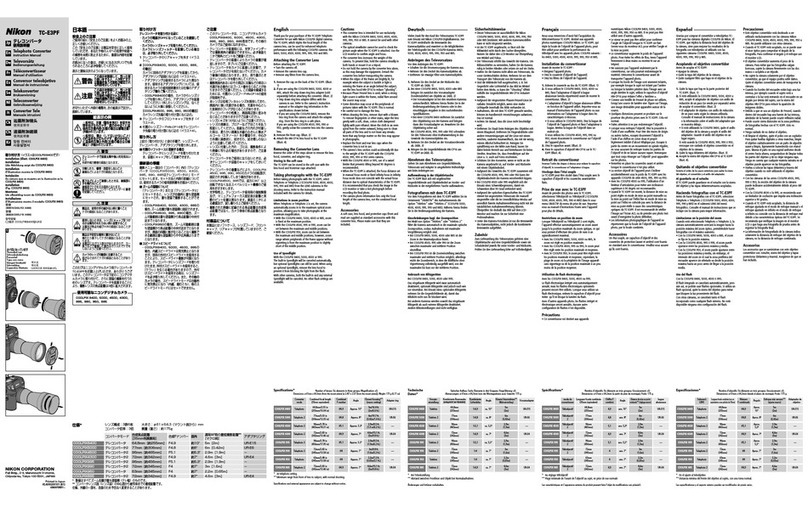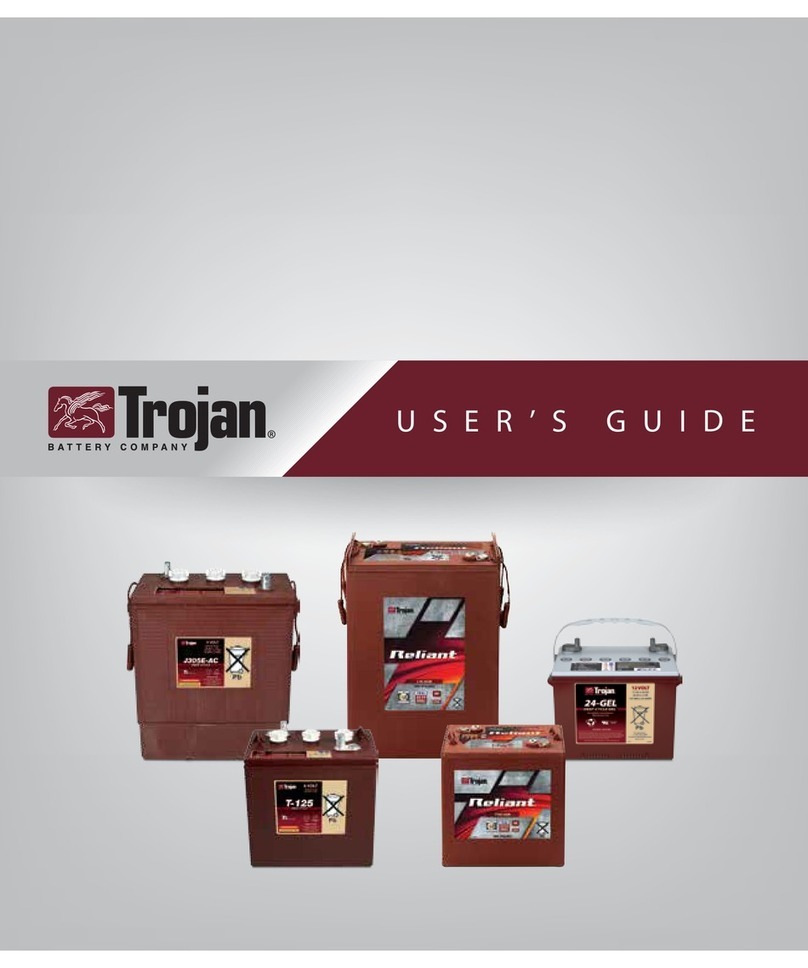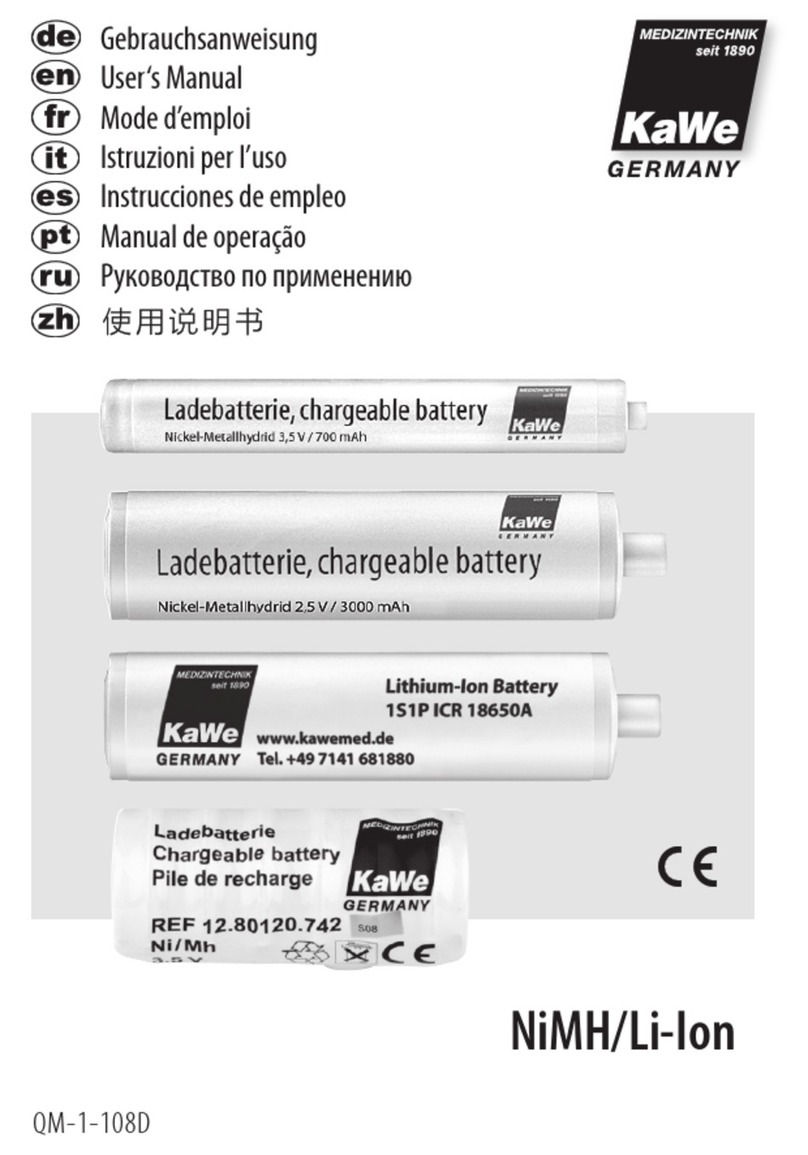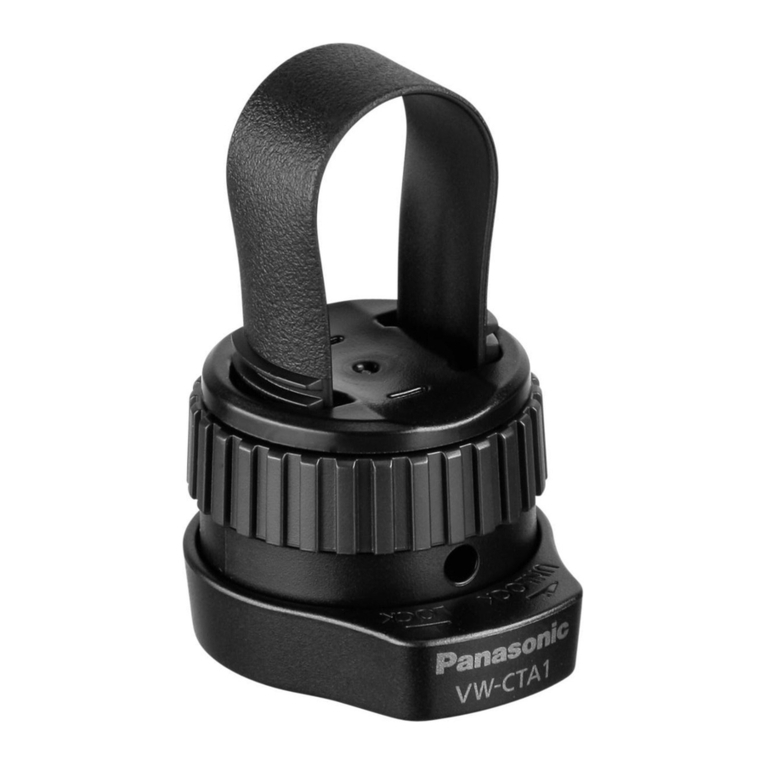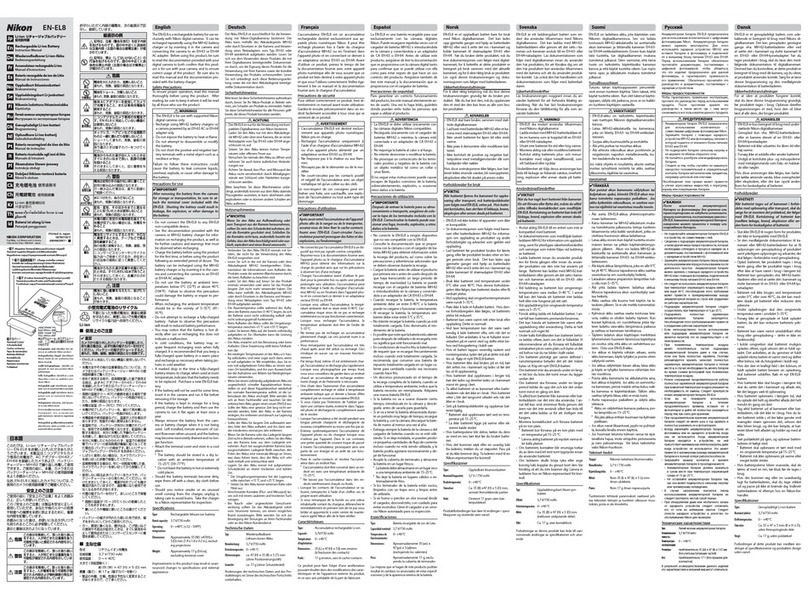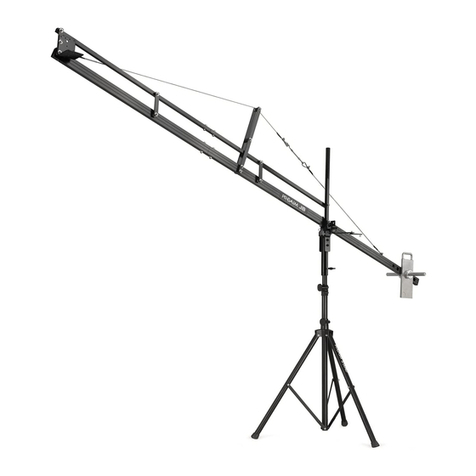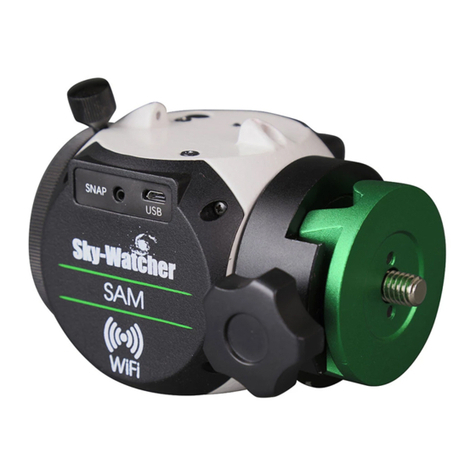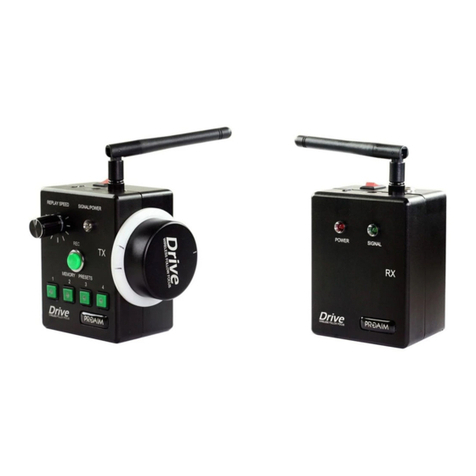Rolls 8HHG2IP User manual

Installation, charging and maintenance
procedures for Rolls fl ooded lead-acid
Railroad & Diesel Starter batteries.
RAILROAD & DIESEL STARTER
BATTERY USER MANUAL

RAILROAD &
DIESEL STARTER

TABLE OF CONTENTS
02 Equipment & Safe Handling Procedure, Inspection
03 Quick Check List, Disposal Procedure
04 Safety
05 Provisions Against Electrolyte Hazard
06 Installation
08 Charging
09 Recommended Float Voltage
10 Specific Gravity
11 Effect of Electrolyte Level On Specific Gravity
11 Maintenance
12 Electrolyte - Adding Distilled Water
12 Watering Intervals
13 Automatic Watering Systems
14 Locomotive Smart Battery Monitoring System
14 Features:
15 Sulfation
16 Other Causes Of Sulfation:
17 Treating Sulfated Batteries That Do Not Respond To Charging at a Low Rate
17 Cell Replacement – Welded Connections
18 Storage
21 Warranty
22 Cross Reference Guide
24 Contacts

23
Rolls Battery has been manufacturing deep cycle lead-acid batteries since 1935.
Experience and commitment to quality has helped us achieve an unmatched reputation
in the industry. Our goal is to provide our customers with a premium product providing
dependable performance and long-lasting cycle life. This manual provides the
recommended setup, charging, Equalization and preventive maintenance procedures
necessary to maximize the life of your Rolls batteries. If you have battery-related questions
beyond the contents of this manual, we encourage you to visit our online Technical Support
Desk (support.rollsbattery.com) for additional information or file a support ticket and our
Technical Support team will be happy to assist you.
EQUIPMENT & SAFE HANDLING PROCEDURE
• Goggles, rubber gloves & rubber boots
• Distilled water
• Baking soda, soda ash
To prevent injury, always wear acid-resistant clothing, PVC gloves, goggles and rubber
boots. Flooded batteries must always be maintained in an upright position. Always have
plenty of water and baking soda on hand in the event of an acid spill during transport.
INSPECTION
When receiving shipment of your batteries, it is important to thoroughly inspect each pallet,
battery and packaging. Before signing acceptance of the shipment, remove the shrink-
wrap from the pallet and inspect each battery for damage (i.e. cracks, dents, punctures,
deformations, acid leaks or other visible abnormalities).
Do not accept shipment if the batteries appear to have been damaged in any way.
Confirm that connection terminals are secure and clean. If the battery is dirty, or if any
minor amount of acid has spilled onto the case due to loose vent caps, refer to the cleaning
instructions in this manual to properly neutralize and clean as necessary. Wet pallets or
signs of acid leak on or around the batteries could indicate shipping damage or improperly
sealed battery casing. Perform a voltage check to confirm the battery polarity and marking
of the terminals are accurate.
In the event of a suspected leak or damage, do not accept the shipment.
Contact your battery retailer or Rolls Battery to determine whether the batter(ies) require
replacement.
Battery shipments which are known to be damaged, but accepted, will not
be replaced under the terms of Rolls Battery manufacturer warranty.
• hydrometer, refractometer
• voltmeter, ammeter
• battery charger

23
QUICK CHECK LIST
SHIPPING/RECEIVING (MUST INSPECT PRIOR TO DRIVER RELEASE!)
• All parts are included
• No acid spills
• No visual damage to the batteries
• Verify electrolyte levels
INSTALLATION
• Protective equipment should be worn
• All electrical components should be turned off
• Acid spill cleanup material should be readily available
INITIAL CHARGE
• Verify electrolyte levels (add distilled water as necessary)
• Measure specific gravity
• Set up battery charge voltage/current limits
GENERAL
• Safety first!
DISPOSAL PROCEDURE
To reduce environmental impact, bring your spent lead-acid batteries to a certified
recycling depot. Lead-acid batteries are 97% recyclable and are the most recycled
consumer product in the world. Closed-loop manufacturing and recycling programs
allows nearly all components to be recycled or re-purposed. A credit by weight for lead
may be offered by recycling depots or facilities for spent batteries.
When processed safely, recycling batteries reduces the release of lead to the environment
and conserves natural resources. Recycled lead production takes only 35-40% of the
energy necessary to produce primary lead from ore. Lead may be recovered and re-
purposed multiple times.
For more information on lead-acid battery recycling, visit https://batterycouncil.org

45
SAFETY
Follow your company’s safety instructions when working with or near locomotive starting
batteries. Observe the warning label affixed to the battery. Thoroughly familiarize yourself
with industry and government guidelines (OSHA, ANSI) for charging, handling and
maintaining locomotive starting batteries.
• Assign battery and charger care to properly trained personnel.
• Lead-acid batteries contain sulfuric acid. Avoid contact with skin, eyes or clothing.
Wear rubber apron, gloves, boots and goggles or face shield when handling, checking,
filling, charging or repairing batteries.
• Keep water readily available for flushing spilled electrolyte from eyes or skin. Use clean
water only and obtain medical attention immediately. Special deluge showers and eye
wash basins are required.
• Flooded lead-acid batteries produce hydrogen during charge which may ignite. Keep
open flames away from the battery at all times. Do not check electrolyte level with
a cigarette lighter or match. Use a flashlight or permanent lights if required. Do not
smoke or create sparks.
Lift batteries with a hoist, crane, lift truck or similar equipment. Move batteries on trucks,
conveyors or rollers. Be sure to place a rubber mat or similar insulating material across
tops of batteries without covers when handling.
Make sure equipment used to move the battery is of ample strength to handle the size
and weight and is properly installed.
CAUTION: DO NOT USE CHAIN, ROPE OR WIRE SLINGS
• Never lay metal tools, such as wrenches or other material on top of a battery.
• Disconnect the battery from the locomotive when performing maintenance and repair
on motor or electrical system.
• Open or “break” battery circuit before attempting repairs to terminal.
• Apply a strong neutralizer, like baking soda, if electrolyte is spilled. Check local
regulations regarding disposal of neutralized waste.

45
PROVISIONS AGAINST ELECTROLYTE HAZARD
Electrolyte and water
Electrolyte used in lead-acid batteries is an aqueous solution of sulphuric acid.
Electrolyte used in NiCd and NiMH batteries is an aqueous solution of potassium hydroxide.
Distilled or demineralised water is used when topping up the cells.
Protective clothing
In order to avoid personal injury from electrolyte splashes when handling electrolyte and/or
vented cells or batteries, protective clothing shall be worn, such as:
• protective glasses or face shields
• protective gloves and aprons
In the case of valve-regulated or gastight sealed batteries, at least protective glasses and
gloves shall be worn.
Accidental contact, “first aid”
Acid and alkaline electrolytes create burns in eyes and on the skin. A source of clean
water, from tap or a dedicated sterile reservoir, shall be provided in the vicinity of the
battery under charging or maintenance for removing electrolyte splashed onto body parts.
Acid and alkaline electrolytes create burns in eyes and on the skin. A source of clean
water, from tap or a dedicated sterile reservoir, shall be provided in the vicinity of the
battery under charging or maintenance for removing electrolyte splashed onto body parts.
Eye contact
In the event of accidental contact with electrolyte, the eyes shall be immediately flooded
with large quantities of water for an extended period. In all cases, immediate medical
attention shall be obtained.
Skin contact
In the event of accidental skin contact with electrolyte, the affected parts shall be washed
with large quantities of water or with adequate neutralising solutions. If irritation of skin
persists medical attention shall be obtained.
Battery accessories and maintenance tools
Materials used for battery accessories, battery stands or enclosures, and components
inside battery rooms shall be resistant to or protected from the chemical effects of the
electrolyte.
In the event of electrolyte spillage, the liquids shall be removed promptly from all surfaces
with absorbing and neutralizing material.

67
Maintenance tools such as funnels, hydrometers, thermometers which come in contact
with electrolyte shall be dedicated either to the lead-acid or NiCd-batteries and shall not
be used for any other purpose.
INSTALL ATION
BLOCKING
When installed, locomotive batteries must be properly blocked in the battery
compartment as shifting or movement may occur which could cause damage to the
battery. All trays should be securely blocked. The battery should be securely and care
taken to avoid over tight wedging. Clearance of approximately 30mm (1/8”) should be left
between the blocking and the battery trays. If reusing old blocking, ensure it is dry and
not waterlogged.
TERMINAL CONNECTIONS
Terminal connections must be clean, tight, and properly torqued. Inspect terminals
connections regularly as they may loosen over time due to vibration and repeated
heating/cooling during the charging process. To prevent terminal damage, calibrate the
torque wrench before use to ensure accuracy.
RECOMMENDED TORQUE SETTING
TERMINAL N-m lb-ft
FLAG, PADDLE RR 27 N-m (max: 33 N-m) 20 lb-ft (max: 25 lb-ft)
NOTE: Damage to terminals and/or batteries caused by under/over-torque is often
unrepairable and is not covered under manufacturer warranty. Distributors or Dealers
may offer replacement or repair, where possible, at the customer’s expense.
ELECTROLYTE INSPECTION
It is normal for electrolyte levels in flooded lead-acid battery cells to drop slightly after
the initial filling during the manufacturing process. When a new battery is received,
electrolyte levels should be checked during the inspection process to ensure the plates
are fully submerged. If cells are low, top up with distilled water.
See ELECTROLYTE-ADDING DISTILLED WATER on pg. 12 for instructions.
Under normal operation, only distilled water should be added to each cell during routine
top up. In the event of a spill, pre-mixed electrolyte may be added by qualified personnel
only. Refer to the battery label for the appropriate electrolyte as this varies by model.
NOTE: Electrolyte supply should be removed from the locomotive shop to prevent
improper filling.

67
TEMPERATURE COMPENSATION & SENSOR INSTALLATION
For charge accuracy and safety, many systems use a sensor mounted to the battery to
measure cell temperature and adjust charge voltage accordingly. When available, the
temperature sensor must be used to avoid improper voltage adjustments.
When using chargers that do not feature temperature compensation, voltage settings
should be monitored and adjusted based on actual cell temperature. Failure to use or
properly install the provided sensor may cause damage due to over/undercharge which
is not covered under Rolls Battery manufacturer warranty. As a precaution, this sensor
may also trigger a programmed safety charge cut-off as the battery should not exceed
an operating temperature of 52ºC (125ºF).
Rolls locomotive & diesel starter models are designed with modular cells with dual-
container construction for added durability and spill protection. Individual 2-volt cells
are bolted or welded together and housed inside an outer red polypropylene case.
To ensure an accurate temperature reading, the temperature sensor must be mounted
directly to the side of an internal cell. See Figure 1 - Temperature Sensor below.
Do not mount the temperature sensor to the top or side of the outer red case, or
to a battery terminal, as these areas will not provide an accurate reading of cell
temperature and may cause the voltage regulator to improperly adjust charge voltage.
To access the cell, disconnect the terminal connections and remove the outer cover
which snaps on to the case or may use small removable plastic pins. Mount the sensor
to the internal cell and run the connecting cable between the case, being careful not
to pinch or damage the wire when placing the cover back on. Automotive silicone is
used to seal around each terminal to protect against spills, dust & debris. This may be
reapplied when the case has been reassembled.
Figure 1 – Temperature Sensor
Dual-Container Locomotive & Diesel Starter Models - Remove case cover. Mount
sensor to the side of internal cell below the liquid level. Replace the cover and re-seal
around terminals with automotive silicone.

89
CHARGING
INITIAL REFRESHER CHARGE
Rolls Railroad & Diesel Starter batteries are fully charged and tested as part of the
quality assurance processes before shipping. Like other lead-acid batteries, it is
normal for these models to self-discharge slightly during transit. The battery will
also self-discharge at any time it is not maintained on a float charge or has been
disconnected and placed in storage. The rate of self-discharge varies by temperature,
increasing in warmer temperatures and at a slower rate in low temperatures.
Before putting the battery into service, it should be placed on an initial refresher charge
to ensure all cells are fully charged and balanced.
To begin, note the Amp-Hour rating and recommended charge voltage range on the
battery label or product specifications to determine the appropriate charge current and
voltage settings. Begin charging the battery at the recommended charge voltage.
When charging begins, the initial charge current will be highest as the battery begins
accepting a charge. This may be as high as 20% of the 8-hour rate of the battery.
As the battery reaches full state-of-charge this is referred to as the finish rate. Charge
current will reduce to 3% of the 20-Hour rate of the battery, indicating the battery has
reached 100% SOC. Battery cells should read 2.35VPC.
VOLTAGE REGULATOR
Rolls Railroad & Diesel Starter models are used to supply power for locomotive engine
starting and when the generating system is not running. Once the engine is running,
the generating system begins charging to replace the power drawn from the battery.
When complete, the battery is held at 100% state-of-charge at the float voltage until it
is discharged again.
Input from the generating system to the battery is controlled by the voltage regulator.
Much like a typical battery charger, it is important that the regulator is operating
properly and charging at the correct voltage. The operating or float voltage
If the voltage regular is not in good operating condition or is adjusted to an incorrect
float voltage, the battery will not function as intended. If the voltage is too low the
battery will be consistently undercharged. If the voltage is too high the battery will be
overcharged which will burn out the cells, shortening cycle life or causing premature
failure.
Over time, low voltage settings will result is deficit cycling where more power is drawn
from the battery than replaced during charging. This will reduce battery capacity and

89
shorten the life of the battery considerably. Undercharge is indicated by a decrease in
specific gravity readings.
Overcharge is commonly identified by faster and/or excessive water loss due to
off-gassing, dark electrolyte due to burning oxide paste or very high specific gravity
readings.
The correct float voltage will charge and maintain the battery at full state-of-charge.
This is determined by two factors – operating temperature and locomotive work
schedule.
When properly installed, a temperature sensor regulates the float voltage,
compensating for changes in cell temperature. See Figure 1 – Temperature Sensor for
instructions.
RECOMMENDED FLOAT VOLTAGE
The recommended float voltage per cell at varying ambient temperatures are as
follows:
TEMPERATURE
FLOAT VOLTAGE
VPC 8 VOLT 32 VOLT
GREATER THAN 27°C (80°F) 2.25-2.30 VPC 9.0-9.20V 36.0-36.8V
10°C (50°F) to 27°C (80°F) 2.30-2.33 VPC 9.20-9.32V 36.8-37.28V
LESS THAN 10°C (50°F) 2.33-2.38 VPC 9.32-9.52V 37.28-38.08V
The effect of locomotive work schedule on the correct float voltage is often determined
by usage and experience. If the battery is used for starting frequently, such as an
auto start/stop where the locomotive may be repeatedly started to warm the engine
when not be in use, the float voltage should often be set at the higher end of the range
indicated at the appropriate temperature; similarly, for infrequent battery usage, the
operating or float voltage should be set at the lower end of the range.
Adjustments in float voltage may be necessary from season to season and in situations
where the batteries have become sulfated.
NOTE: It is recommended that float voltage regulator adjustments be made while the
engine is at operating speeds.

10 11
SPECIFIC GRAVITY
The specific gravity of electrolyte in a battery cell is the most accurate measurement
of actual state-of-charge. Specific gravity decreases during discharge and increases
again as the battery is charged. To determine if a battery has reached full charge, test a
sample of the electrolyte in each cell using a hydrometer or refractometer.
The specific gravity of a fully charged battery will vary according to the pre-mixed
electrolyte added during manufacturing. For reference, this is noted on the battery label.
RAILROAD & DIESEL
STARTER MODELS ELECTROLYTE
8V MODELS 1.250 S.G.
32V MODELS 1.265 S.G.
Routine testing of specific gravity in flooded lead-acid batteries provides an opportunity
to quickly identify any notable changes in battery performance caused by charge-
related issues such as over/undercharging, sulfation buildup, capacity loss, cell/battery
performance or failures.
Routine testing and tracking of specific gravity readings is suggested as part of the
normal battery maintenance procedures. When monitored regularly, varying or low
readings may be identified early on, and charge adjustments made to quickly correct
and prevent any further issue or damage.
EFFECT OF TEMPERATURE ON SPECIFIC GRAVITY
Temperature will affect the specific gravity reading of electrolyte. When taking specific
gravity readings with a hydrometer or refractometer, it is important to correct for
ambient temperature.
To adjust a specific gravity reading for varying ambient temperature, one point (.001)
should be added for every 1.6°C (3°F) above 25°C (77°F). Alternatively, one point (.001)
should be deducted for every 1.6°C (3°F) below 25°C (77°F).
As an example, a specific gravity reading of 1.265 at 17°C (63°F) corrected for
temperature would be 1.260. A specific gravity reading of 1.265 at 30°C (86°F)
corrected for temperature would be 1.268.
Battery capacity is also based on each cell having an electrolyte temperature of 25°C
(77°F). Temperatures below 25°C (77°F) reduce the battery’s effective capacity and
lengthen the time to restore to full capacity. Temperatures above 25°C (77°F) will
slightly increase capacity but will also increase self-discharge rates as well as cell
degradation, shortening battery life.

10 11
EFFECT OF ELECTROLYTE LEVEL ON
SPECIFIC GRAVITY
Varying electrolyte levels will affect the specific gravity reading of electrolyte. The
specific gravity reading will decrease as distilled water is added to cells and will
increase as the electrolyte level decreases. Over time, it is normal for the electrolyte
level in each cell to drop as water evaporates during the charging process.
For reference, a decrease of 31mm (1/8”) in electrolyte level will typically result in an
approximate increase of .003 in specific gravity.
MAINTENANCE
VENTILATION & VENT CAPS
Hydrogen gas is produced when charging flooded lead-acid batteries. To avoid a
buildup of gas and/or risk of explosion, proper ventilation is required, and the battery
vent caps must be kept clean and properly installed. Remove dust, dirt or other
material that may prevent the free circulation of air. The batteries should be inspected,
and vent caps removed, cleaned, and replaced periodically as part of the regular
maintenance procedure.
A sticky dark gray residue may be visible on the inside of the standard 1/4-turn
bayonet, R-Caps or watermiser vent caps on flooded battery cells. This buildup of
dirt and dried electrolyte is quite common and, over time, may clog the vent holes
preventing the release of hydrogen off-gas during charging. Inspect the caps and clean
using a neutralizing baking soda and water solution as necessary.
CLEANING STEPS:
1. Clean the vent caps by soaking in a solution of water and baking soda (100g per
litre) in a bucket or small bowl. Let the vent caps sit overnight to neutralize and
break down any electrolyte in the caps.
2. Flush the vent caps clean by forcing water through the vent holes. Water should
drip freely. A trickle of water should flow from all vent holes, indicating the cap is
clear of debris.
3. Allow the vent caps to dry completely. Once dried, shake recombination caps
(where supplied) to make sure the condensing beads on the inside of the cap rattle
slightly. If you do not hear the beads, let the cap dry for an additional 12 hours or
repeat the process above.

12 13
ELECTROLYTE - ADDING DISTILLED WATER
When adding water, always use distilled water or water that is known to be free of
impurities. Improper watering may cause internal cell damage. Test water to confirm a
PH reading of 7 or less and no Total Dissolved Solids (TDS < 5 PPM). A TDS meter may
be used to test and determine an accurate measure of water purity.
Contact Rolls Battery Technical Support or your local Dealer if you have questions or
are unsure of your water quality.
NOTE: Only distilled water should be used when topping up cells. Do not add sulfuric
acid to flooded battery cells during routine top up. In the case of accidental spill,
premixed electrolyte at the appropriate specific gravity may be used to refill cells.
See battery label for reference.
Figure 2 – Adding distilled water
CAUTION: Do not add water or electrolyte to cells before initial charging unless the
plates are exposed. If so, add distilled water until plates are fully submerged. Please
contact Rolls Technical Support if you have any questions or concerns.
NOTE: Routine cell inspection should be completed to maintain adequate electrolyte
in all cells during battery operation and storage. If the electrolyte level drops below the
top of the plates the exposed surfaces will harden and become sulfated. In this case,
capacity loss and cell damage are often permanent.
WATERING INTERVALS
Flooded lead-acid batteries, during normal operation, will generate hydrogen and
oxygen from water in the electrolyte and will require refilling periodically.
Gassing or water consumption in a battery is a function of float voltage and operating
temperature. Excessive water consumption indicated the voltage regulator setting is
too high and should be reduced. Typically, it should not be necessary to add distilled
water to the battery more than once every 30-90 days in warmer summer months and
once every 60-90 days in cooler winter months.
Electrolyte should be kept
at 1/2” below vent tube.
Electrolyte
level
Open cell
1/4” - 1/2”
Maximum electrolyte level specified
by the battery manufacturer
6mm - 13mm
1/4" - 1/2"
Electrolyte level should
be kept below vent
tube to prevent overflow
during charge.

12 13
If a gradual decrease in specific gravity readings is noted, or the readings consistently
remain 10 to 20 points below the noted specific gravity at full charge, the voltage
regulator is set too low for the locomotive’s work schedule, and it should be increased
to allow more charge. Do not increase or decrease the voltage regulator setting
more than 0.5 volts at a time. Recheck the battery after each adjustment to see if an
additional change in is necessary.
NOTE: Select Rolls Battery Railroad & Diesel Starter models have been specifically
designed with a larger electrolyte reserve to allow for extended watering intervals (up
to 180 days). Refer to the product specifications for the noted electrolyte reserve for
each model.
AUTOMATIC WATERING SYSTEMS
Frequent locomotive starts demand aggressive charging of the locomotive batteries,
resulting in increased water use. To avoid damage and ensure cranking amps are
available, it is important that the proper electrolyte level is maintained in each cell.
Rolls Locomotive Single-Point Watering Systems by Flow-Rite will automatically top up
the correct amount of distilled water in each cell in 1-2 minutes is the only single point
watering system designed specifically for locomotives. Designed to eliminate the need
to lift or remove a battery for watering, the Rolls Locomotive Single-Point Watering
System is the only watering system with internal flame arrestors and includes a de-gas
chamber to allow normal release of gasses. This system has been specifically designed
to allow for electrolyte expansion to avoid dangerous acid spills.
• Installs on all major brands of locomotive starting batteries
• Low profile design fits in locomotive battery compartments
• Acid resistant, polypropylene components and tubing
• Designed to survive extreme temperatures and vibrations
NOTE: To ensure proper operation, routine inspection of watering systems is
recommended.
Contact your Rolls Battery distributor or dealer for more information. When requesting
pricing, indicate the battery make, model and preferred water supply.

14 15
LOCOMOTIVE SMART BATTERY
MONITORING SYSTEM
To operate efficiently, locomotives rely on dependable deep cycle batteries for engine
starting. Proper charging and maintenance is key to maximizing battery performance
including capacity, starting crank Amps and cycle life. Utilizing a simple and easy-to-
read LED visual indicator and audible alerts, Rolls integrated Locomotive Smart Battery
Monitor offers maintenance crews supportive information relating to battery health as
well as state-of-charge and engine starting ability.
Select Rolls 32-volt locomotive models (16 CH 25R-MON, 16 CH 33R-MON) are
equipped with an integrated Rolls proprietary Locomotive Smart Battery Monitor to
track and provide real-time undercharge monitoring, discharge monitoring, impedance
monitoring as well as performance & maintenance alerts with simple audio & visual
communication.
FEATURES:
BATTERY UNDERCHARGE INDICATOR: Chronic undercharging reduces cycle life
and is a specific concern with automatic engine start/stop (AESS) control systems.
Rolls Locomotive Smart Battery Monitor alerts where incidents of undercharge may
be occurring, helping guide operators to perform regular and restorative maintenance
charges to avoid capacity loss and maintain starting performance.
CHARGE COMPLETE: Accurately tracking charge current and battery voltage, Rolls
Locomotive Smart Battery Monitor assists in identifying when the battery has reached
full state-of-charge and charging may be terminated. A unique LED sequence helps to
confirm the charge is complete and the battery is now ready to be put into service.

14 15
SERVICE HOURS: Tracking battery age and charge cycles, Rolls Locomotive Smart
Battery Monitor features a visual LED & audible alarm to identify batteries in service
which have reached their specified or expected end-of-life period. This audio/visual
indicator helps to ensure timely battery replacement and safeguard against unexpected
fail-to-start events.
LOW STARTING PERFORMANCE: Rolls Locomotive Smart Battery Monitor continually
monitors battery starting capability. Using a rising audible alert & LED, the monitor
notifies operators of below specification starting performance due to increased
battery impedance, suggesting a restorative maintenance charge & testing should be
completed.
OVER DISCHARGE ALERT: Unintentional deep discharges reduce battery life and
create fail-to-start conditions. Ensuring adequate charging and avoiding heavy
discharge will maintain battery capacity and cranking performance. Using a combined
LED indicator and continuous audible alarm, Rolls Locomotive Smart Battery Monitor
alerts operators during incidents of abnormally low discharge which may lead to a fail-
to-start event, suggesting a restorative maintenance charge & testing be performed
before use.
SULFATION
When a battery is being discharged the lead active material on the plates will react
with the sulfate from the electrolyte forming a lead sulfate on the plates. When there is
no lead active material and or sulfate from the electrolyte remaining the battery then is
completely discharged. After a battery reaches this state, it must be recharged. During
recharge, the lead sulfate is reconverted into lead active material and the sulfate
returned to the electrolyte.
When the sulfate is removed from the electrolyte the specific gravity is reduced and the
reverse takes place when the sulfate is returned to the electrolyte. The most accurate
measure of state-of-charge for flooded lead-acid battery cells is a specific gravity test
using a hydrometer or refractometer.
If a battery is left in a discharged condition the lead sulfate will harden and have a high
electrical resistance. This is what is normally called a sulfated battery. The lead sulfate
may become so hard that normal recharging will not break it down. Most charging
sources, engine alternators and battery chargers, are voltage regulated. Their charging
current is controlled by the battery’s state of charge. During charging, battery voltage
rises until it meets the charger’s regulated voltage, lowering the current output along
the way.

16 17
When hard sulfate is present, the battery shows a false voltage, higher than its true
voltage, fooling the voltage regulator into thinking that the battery is fully charged. This
causes the charger to prematurely lower current output, leaving the battery discharged.
Charging at a higher-than-normal voltage and low current may be necessary to break
down the hardened sulfate.
Hardened sulfate also forms in a battery that is constantly being cycled in the middle
of its capacity range (somewhere between 80% charged and 80% discharged) and is
never recharged to 100% SOC. Over time, a portion of the plate’s active materials turns
into hard sulfate. If the battery is continually cycled in this manner, it will lose more
and more of its capacity until it no longer has enough capacity to perform the task
for which it was intended. An equalizing charge, applied routinely every three to four
weeks, should prevent the sulfate from hardening.
In both cases, the fact that the battery “won’t take a charge” is a result of improper
charging procedures which allowed the sulfate to harden. In most instances, it is
possible to salvage a battery with hardened sulfate. The battery should be charged
from an outside source at 2.6 to 2.7 VPC and a low current rate (approximately 10-
Amps) until the specific gravity of the electrolyte starts to rise. (This indicates that the
sulfate is breaking down.)
To prevent cell damage, be careful not to let the cell temperature of the battery rise
above 51°C (125°F). If it does, turn the charger off and let the battery cool. Then,
continue charging until each cell in the battery is brought up to full charge, verified by
specific gravity readings. The time needed to complete this recharge depends on how
long the battery has been discharged and how hard the sulfate has become.
If a battery does not seem to be taking or holding a charge, test the specific gravity of
each cell with a hydrometer or refractometer. If all cells are reading low even after an
extended charge, it is likely that hardened sulfate that has accumulated on the plates.
By following the instructions outlined above, the problem may be corrected.
OTHER CAUSES OF SULFATION:
LOW ELECTROLYTE LEVEL - If the electrolyte level in a cell drops below the top of the
plates the exposed surfaces will dry, harden and become sulfated. In this case, cell
damage and capacity loss is usually permanent.
ADDING ELECTROLYTE - If premixed electrolyte is added to a sulfated cell, the
condition will be aggravated.
HIGH SPECIFIC GRAVITY – High specific gravity of electrolyte increases the
accumulation of sulfation. Batteries which reach a full state-of-charge, as measured by
specific gravity on a regular (weekly) basis, are much less likely to experience sulfation
buildup.

16 17
HIGH TEMPERATURE – High operating temperatures will also accelerate sulfation
buildup. This is often noticeable in an idle, partially discharged battery.
TREATING SULFATED BATTERIES THAT DO NOT
RESPOND TO CHARGING AT A LOW RATE
1. Follow regular charging procedures at the recommended charge voltage &
charge rate.
2. Complete a discharge test to determine battery capacity. See pg. 19 for
instructions.
3. If there is a gradual improvement but 80% of rated capacity is not reached,
continue to repeat steps 1 and 2 until 80% capacity has been reached or no
further improvement is noted. If no improvement is noted, discontinue test and
replace battery.
4. If the battery has not responded to the above procedure, the battery may be
permanently sulfated or the electrolyte may have been spilled or flushed from the
cell and replaced with water.
CELL REPLACEMENT – WELDED CONNECTIONS
Depending on the battery model, cells may have bolt-on or welded connections. If a
cell replacement is required and the connections are welded, follow the steps below to
safely disconnect, remove and replace a cell.
1. Disconnect the battery terminal connections, remove lead nuts & bolts, and each
of the cell vent caps.
2. Remove the automotive silicone around each battery terminal by running a knife
along edge of terminals to separate silicon sealant from terminal.
3. If plastic fasteners are used on the battery cover, carefully remove with a
screwdriver.
4. Remove the battery cover by lifting from the edge. If it is difficult to remove, tap
the bottom of the corners with a hammer to lift the edge.
5. With the battery cover removed, blow into each cell to drive out any accumulated
hydrogen gas to avoid igniting during the cell replacement. Stand back as far as
possible and pass a lighted torch over each cell opening to remove any remaining
hydrogen gas. When complete, replace the vent cap on each cell.

18 19
6. On the cell to be removed, with # 53 hollow post drill bit, drill a hole where the
connectors join the cell on each side to disconnect.
7. Using a 3/16 polypropylene rope, make a sling by slipping the rope under all
connectors of the cell to be removed. Slowly lift the cell using the sling to remove.
8. If the defective cell will be replaced with a used cell from another battery, use the
electrolyte from the used cell.
9. If the old connectors are to be used again, clean with a wire brush, neutralize and
dry. Clean the inside hole of the connector with a knife.
10. Repeat step #6 on the replacement cell. Once completed, use the # mu-71 torch
to weld the connectors on the replacement cell.
11. Remove the vent caps from each cell before reinstalling the battery cover. When
replacing the battery cover ensure that the rubber rings on all vent well openings
are properly aligned. Push down on each ring to ensure a snug fit. When the cover
is aligned, tap on the top of the cover to snap it in place and replace the plastic
fasteners (if used) to secure.
12. Replace the vent caps, lead nuts and bolts, and reseal around the battery
terminals with silicone.
13. Place the battery on charge at the finish rate until specific gravity readings and
cell voltages are balanced.
STORAGE
GENERAL CARE:
Spare charged batteries should be cleaned regularly and stored in a clean, cool, dry
place, free from dust and debris.
Stored batteries should be recharged every 3 months until the battery is put in service
to avoid sulfation buildup and possible freezing in cold temperatures. Electrolyte may
freeze if the battery becomes discharged to approximately 50% SOC at -20ºC (-4ºF)
Railroad & Diesel Starter models with Advanced NAM carbon additive may see an
increased self-discharge rate of 20-25% per month at 25ºC (77ºF) when not in use. A
refresher charge may be necessary every 2-3 months.
This manual suits for next models
14
Table of contents
Other Rolls Camera Accessories manuals
